Frogs in general eat a wide range of plants and animals. Tadpoles tend to be herbivores, eating algae, plant matter and detritus, while adult frogs are carnivores eating insects, molluscs and worms.
What is a pond?

There are many different kinds of ponds across the world. In general, ponds are small bodies of still water, however they can be temporary or permanent, shallow or deep, they can be situated on fields, in forests or even on mountains.
Some ponds sit isolated within the landscape, whereas others can be part of vast wetland systems. Most ponds evolve over time. Sediments depositing at their base slowly fills in the water, while vegetation encroaches from the edges.
Some ponds are periodically refilled as rivers flood or seasonal rains appear. Others dry up regularly. All of these differences mean ponds can vary in the kind of life they support.
Of course there are also garden ponds. These are often man-made rather than natural. Most gardeners decide to line their ponds with a plastic lining to avoid water escaping.
Do frogs live in ponds?
Amphibians of all kinds are generally attracted to water. This is in part because they often have very thin skin, meaning they lose water very quickly.
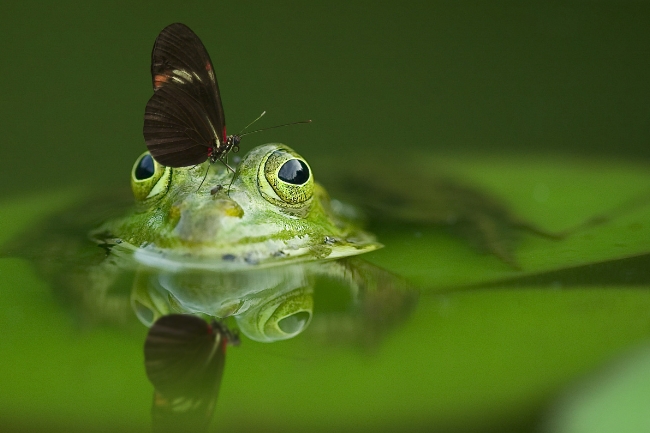
Across the world there are around 7,000 species of frog, living in many different kind of habitats. Frogs can be found in tropical rainforests, rivers, grasslands and even deserts. Most are not entirely aquatic, though many will spend a great deal of time in water.
Water is often particularly important during the mating period, as most tadpoles live with the water until they become young frogs.
While many of us associate frogs with ponds, many will live in rivers or lakes, or even simply within pools of water that form within plants such as bromeliads.
Many species will be happy to use a variety of different wetland habitats, and few species specialize to ponds, while many will make use of them.
Also read: Here’s “How Frogs Find Ponds”
What do frogs eat in a pond?
| Frog Species | Prey Items | Additional Information/Explanation |
|---|---|---|
| Bullfrog | Insects, small fish, tadpoles, crustaceans | Bullfrogs are opportunistic feeders and have a diverse diet that includes both animal and plant matter. They have been known to consume smaller frogs and even birds as well. |
| Green Frog | Insects, spiders, small fish, snails | Green frogs primarily feed on insects and spiders but may also consume small fish and snails. They are sit-and-wait predators, using their long, sticky tongue to catch prey. |
| Leopard Frog | Insects, spiders, earthworms, small fish | Leopard frogs are insectivorous and feed on a variety of small invertebrates like insects, spiders, earthworms, and occasionally small fish. They are agile hunters and rely on their keen eyesight to locate prey. |
| Tree Frog | Insects, mites, spiders, small invertebrates | Tree frogs mainly feed on insects, mites, spiders, and small invertebrates found in the surrounding vegetation. They are skilled climbers and use their adhesive toe pads to capture prey. |
Tadpoles
Most frogs start as eggs. These are laid by the females in their chosen locations. Eggs are usually laid in large clutches. Tadpoles emerge from the eggs with no legs, and long tails.
They spend their time within the water, swimming around and feeding. Over time they begin to grow legs, and their tail disappears.
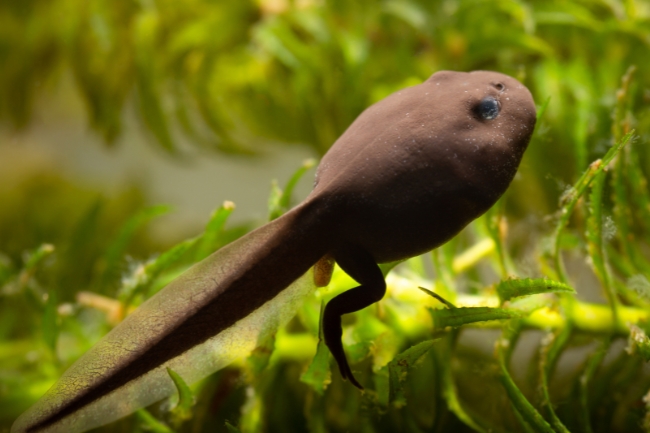
Once they have become froglets, they are able to emerge from the water, and begin a life similar to an adult frog. So what do these tiny tadpoles eat while swimming around the pond?
- Frog eggs
A tadpole’s first food will be within their own eggs, the tasty yolk that will help them develop. As they emerge they may also eat the rest of their eggs.
- Detritus
The main food of most tadpoles is detritus found at the bottom of the pond. This will be organic waste that has floated down from above. It may be made up of plant water, animal feces or dead animals.
- Plankton
Plankton are microscopic animals, who float in the water column, feeding on other floating debris. A wide range of species make up plankton, including the young of bivalves and crustaceans.
Tadpoles, like many aquatic animals, eat these small but easy morsels, as part of their diet.
- Algae
Algae are a group of aquatic plants, which includes seaweeds. They are often common within pond environments. Many algal species are small and easy for tadpoles to feed off.
- Mosquito larvae
Tadpoles are mostly herbivores, unlike their adult counterparts. However, many species will also eat easy and available sources such as mosquito larvae.
Adults
Adult frogs can live between 2-10 years. In this time they can spend time both in and out of water. While most will come to water to breed, they may also spend time in other habitats the rest of the time. This can help them find food, or shelter, or avoid harsh weather conditions.
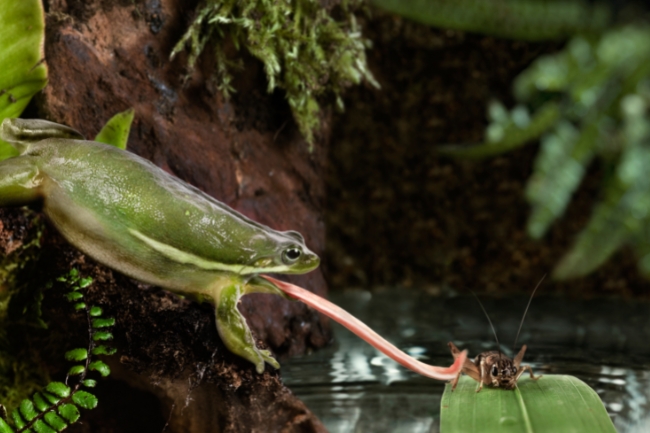
During very dry or cold periods they may enter a state similar to hibernation, often finding sheltered spots away from the water.
Most frogs eat a wide range of foods, taking advantage of whatever is available, rather than specializing. Frogs do not chew, instead swallowing their food whole.
This means they cannot handle prey that is too large for them, or might defend itself too vigorously.
- Flies
Flies that the archetypal frog food. In part, this is because they are plentiful, and usually small and defenseless. With their large tongues, it’s easy for frogs to reach out and pluck flie’s off plants nearby.
- Insects
As well as flies, frogs will eat a wide range of other insects. They will eat both adult and juvenile insects, some of whom have aquatic life cycles.
Beetles are often a popular form of food, as well as damselflies and mosquitos.
- Molluscs
Slugs and snails are easy food for most frogs. They are slow moving, have no defense mechanisms, and are nutritious food.
- Worms
Worms are another popular food. Worms live both in the terrestrial environment and within the water. Like molluscs they are easy to catch and have little in the way of defense.
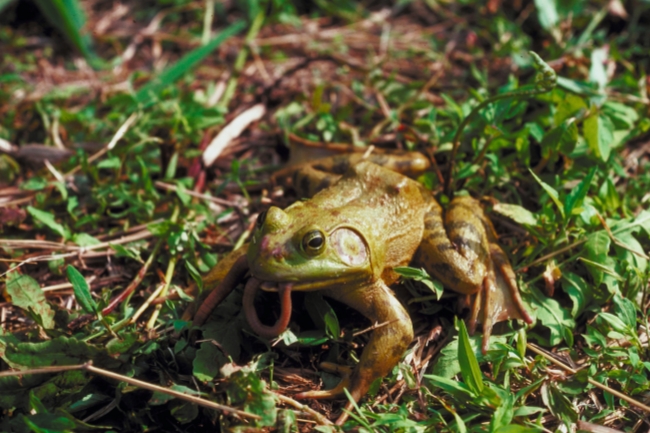
- Fish
Some frog species will happily eat fish, however, fish are often faster than a frog’s usual fare. Because of this, fish are more likely to be eaten when found already dead.
- Lizards
Some larger frog species will eat some reptile species such as lizards. Such a large and fast meal isn’t the easiest to come by, and frogs will catch them through a lucky ambush rather than pursuit.
- Mammals
As with reptiles, some frogs will eat small mammals. This can be species such as mice, shrews and voles. However, such meals aren’t easy to come by.
How often do pond frogs eat?
How often a frog needs to eat will depend on how big they are, and what their prey is.
Most frogs do not need to eat regularly, and may only eat once a day or once every few days. However, as frogs are highly opportunistic feeders, they may at times feed more or less regularly.
| Frog Species | Plant Matter Consumed | Additional Information/Explanation |
|---|---|---|
| Northern Cricket Frog | Algae, aquatic plants, small fruits | Northern cricket frogs consume plant matter such as algae, aquatic plants, and occasionally small fruits. They primarily feed on insects and other small invertebrates, but plant material supplements their diet. |
| Wood Frog | Algae, plant matter, small invertebrates | Wood frogs have a varied diet that includes both plant matter, such as algae and other aquatic vegetation, and small invertebrates. They opportunistically feed on available resources in their habitat. |
| American Bullfrog | Aquatic plants, algae, submerged vegetation | While American bullfrogs are predominantly carnivorous, they may consume small amounts of aquatic plants and algae, especially when other prey sources are scarce. |
| Gray Tree Frog | Fruits, nectar, pollen, plant matter | Gray tree frogs consume a variety of plant matter, including fruits, nectar, pollen, and small amounts of plant material. However, they primarily rely on insects and other small invertebrates for nutrition. |
Being well-fed can also be more important at key times of year, such as prior to the breeding season or winter.
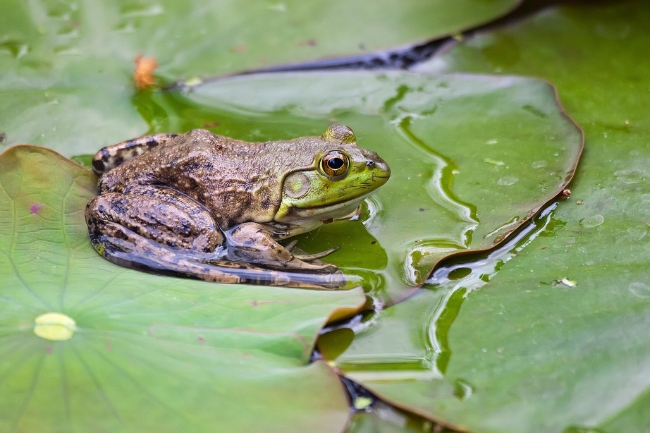
Life on a lilypad
Frogs have lives that revolve around food, safety and mating. When not feeding they try to ensure that they aren’t the next on the menu.
From birds to mammals to fish, there are plenty of creatures that are happy to eat a big fat frog. The young tadpoles can be particularly at risk, and ponds with high numbers of fish are often too dangerous for these little amphibians to survive.
So if you want to encourage a few frogs, leave your pond fish-free.

